Role of Microfinance and Informal Finance in Saudi Arabia
VerifiedAdded on 2023/01/20
|16
|2925
|27
Report
AI Summary
This report delves into the critical role of microfinance and informal finance in stabilizing the Saudi Arabian economy. It examines the impact of these financial instruments on the micro sector, including the poor and MSMEs, within the context of Islamic finance. The study investigates the effects on financial stability, considering factors like loan defaulters and business growth. The research methodology encompasses both secondary and primary research, including interviews and surveys to gather qualitative and quantitative data. The report explores the objectives of microfinance, its relationship with the environment, and gaps in existing literature. It seeks to answer key research questions about the rise or fall of loan defaulters, the effects of informal finance, and the performance of the MSME sector post-microfinance implementation, providing a detailed overview of the financial landscape in Saudi Arabia.
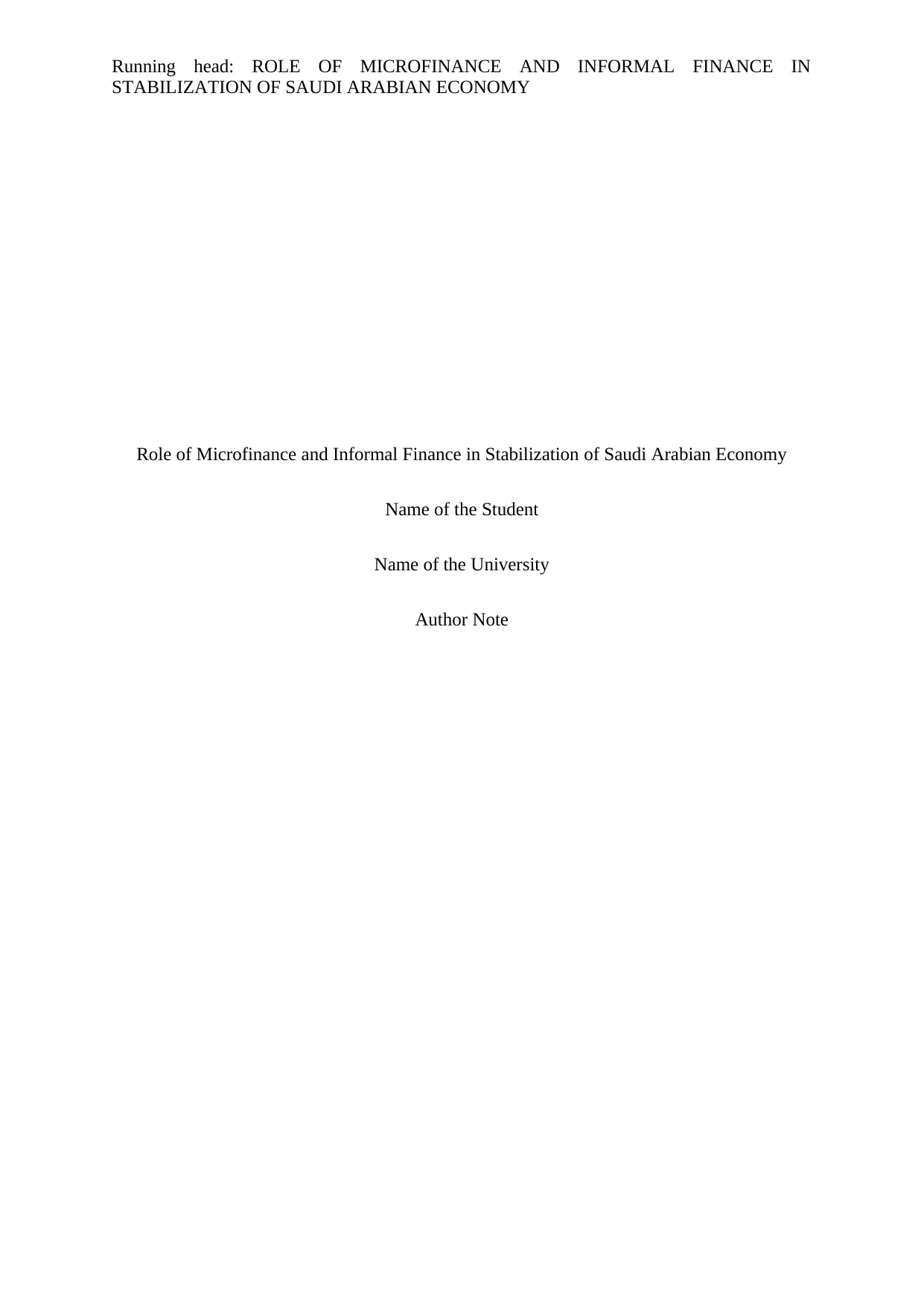
Running head: ROLE OF MICROFINANCE AND INFORMAL FINANCE IN
STABILIZATION OF SAUDI ARABIAN ECONOMY
Role of Microfinance and Informal Finance in Stabilization of Saudi Arabian Economy
Name of the Student
Name of the University
Author Note
STABILIZATION OF SAUDI ARABIAN ECONOMY
Role of Microfinance and Informal Finance in Stabilization of Saudi Arabian Economy
Name of the Student
Name of the University
Author Note
Paraphrase This Document
Need a fresh take? Get an instant paraphrase of this document with our AI Paraphraser
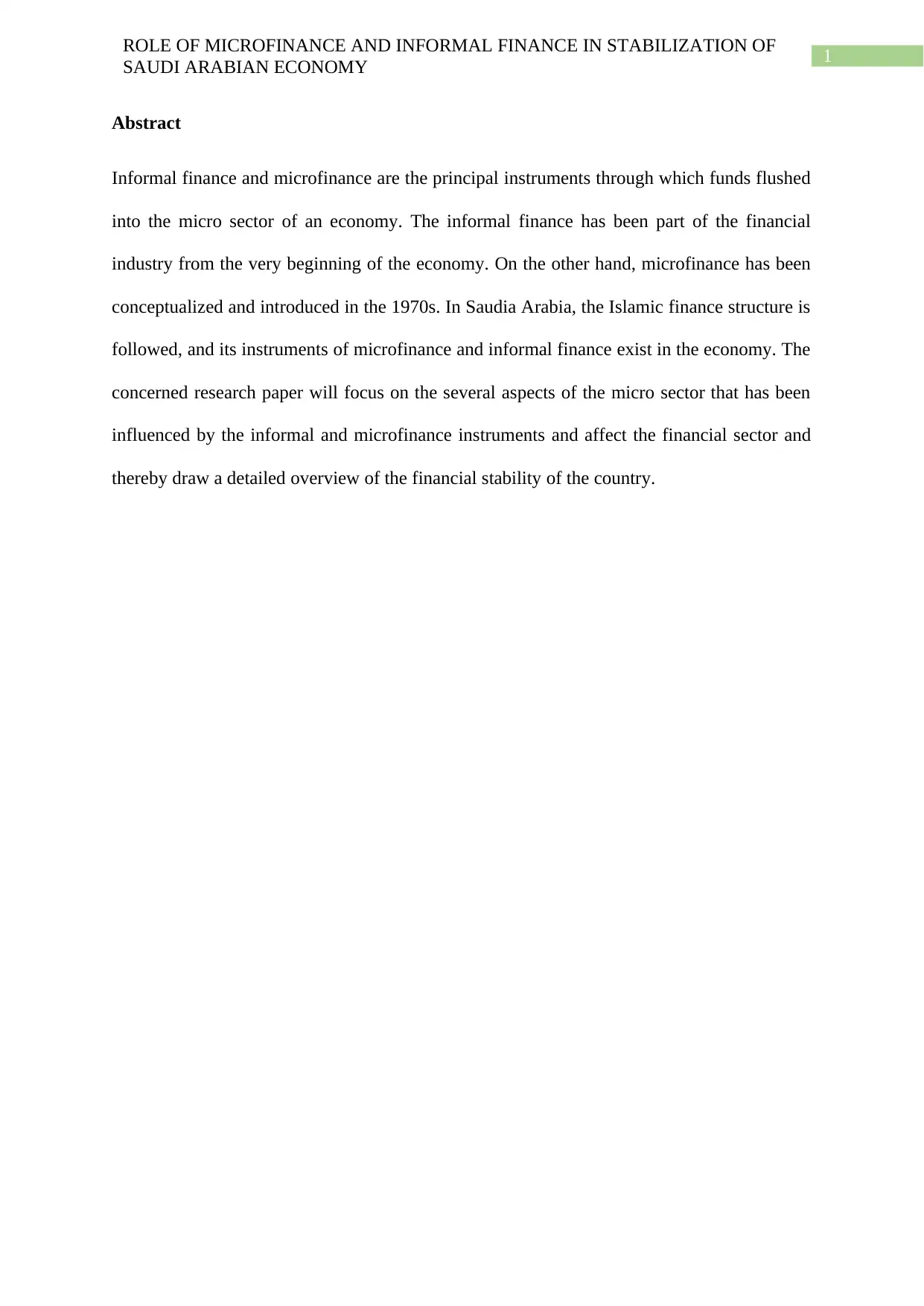
1
ROLE OF MICROFINANCE AND INFORMAL FINANCE IN STABILIZATION OF
SAUDI ARABIAN ECONOMY
Abstract
Informal finance and microfinance are the principal instruments through which funds flushed
into the micro sector of an economy. The informal finance has been part of the financial
industry from the very beginning of the economy. On the other hand, microfinance has been
conceptualized and introduced in the 1970s. In Saudia Arabia, the Islamic finance structure is
followed, and its instruments of microfinance and informal finance exist in the economy. The
concerned research paper will focus on the several aspects of the micro sector that has been
influenced by the informal and microfinance instruments and affect the financial sector and
thereby draw a detailed overview of the financial stability of the country.
ROLE OF MICROFINANCE AND INFORMAL FINANCE IN STABILIZATION OF
SAUDI ARABIAN ECONOMY
Abstract
Informal finance and microfinance are the principal instruments through which funds flushed
into the micro sector of an economy. The informal finance has been part of the financial
industry from the very beginning of the economy. On the other hand, microfinance has been
conceptualized and introduced in the 1970s. In Saudia Arabia, the Islamic finance structure is
followed, and its instruments of microfinance and informal finance exist in the economy. The
concerned research paper will focus on the several aspects of the micro sector that has been
influenced by the informal and microfinance instruments and affect the financial sector and
thereby draw a detailed overview of the financial stability of the country.
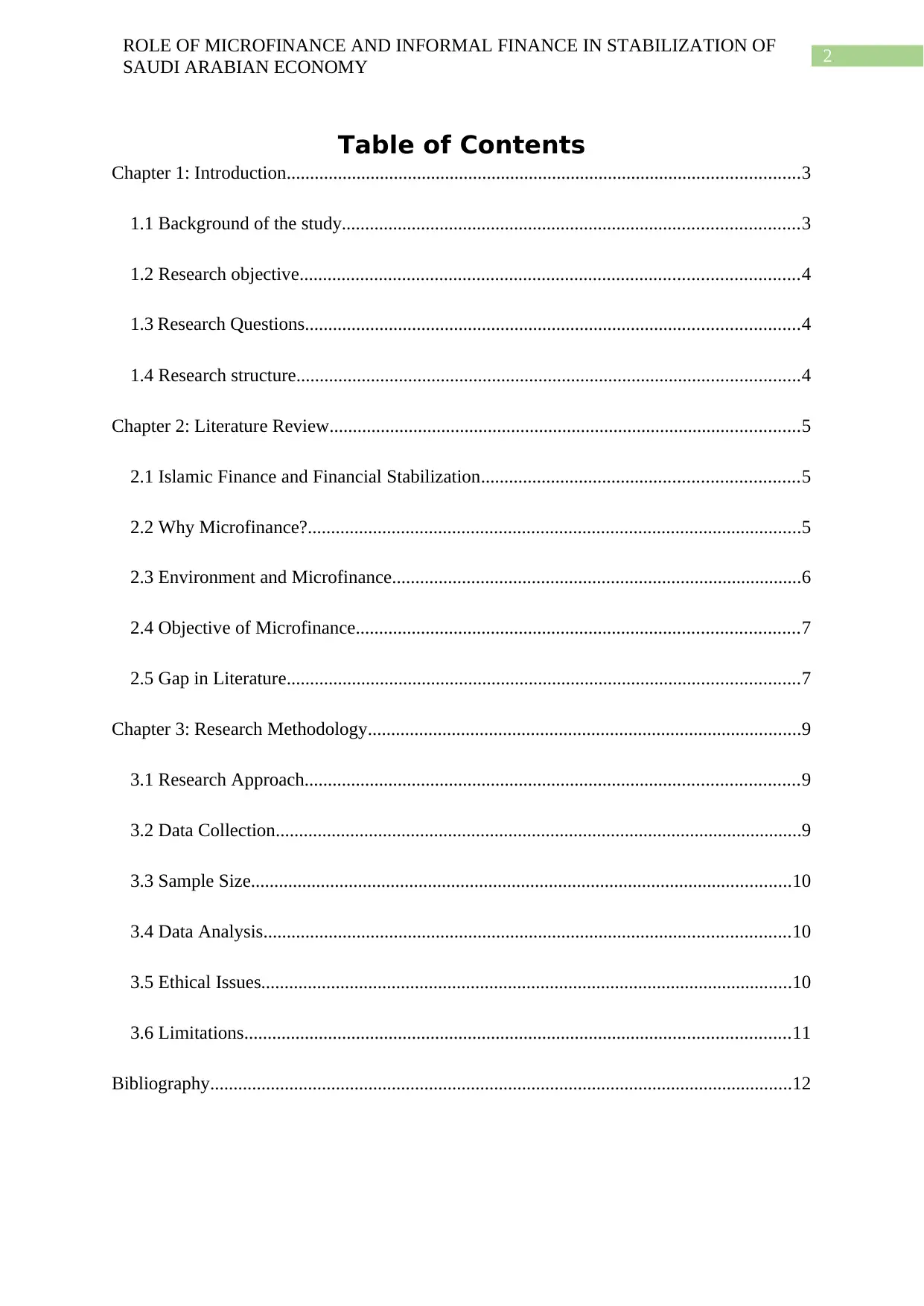
2
ROLE OF MICROFINANCE AND INFORMAL FINANCE IN STABILIZATION OF
SAUDI ARABIAN ECONOMY
Table of Contents
Chapter 1: Introduction..............................................................................................................3
1.1 Background of the study..................................................................................................3
1.2 Research objective...........................................................................................................4
1.3 Research Questions..........................................................................................................4
1.4 Research structure............................................................................................................4
Chapter 2: Literature Review.....................................................................................................5
2.1 Islamic Finance and Financial Stabilization....................................................................5
2.2 Why Microfinance?..........................................................................................................5
2.3 Environment and Microfinance........................................................................................6
2.4 Objective of Microfinance...............................................................................................7
2.5 Gap in Literature..............................................................................................................7
Chapter 3: Research Methodology.............................................................................................9
3.1 Research Approach..........................................................................................................9
3.2 Data Collection.................................................................................................................9
3.3 Sample Size....................................................................................................................10
3.4 Data Analysis.................................................................................................................10
3.5 Ethical Issues..................................................................................................................10
3.6 Limitations.....................................................................................................................11
Bibliography.............................................................................................................................12
ROLE OF MICROFINANCE AND INFORMAL FINANCE IN STABILIZATION OF
SAUDI ARABIAN ECONOMY
Table of Contents
Chapter 1: Introduction..............................................................................................................3
1.1 Background of the study..................................................................................................3
1.2 Research objective...........................................................................................................4
1.3 Research Questions..........................................................................................................4
1.4 Research structure............................................................................................................4
Chapter 2: Literature Review.....................................................................................................5
2.1 Islamic Finance and Financial Stabilization....................................................................5
2.2 Why Microfinance?..........................................................................................................5
2.3 Environment and Microfinance........................................................................................6
2.4 Objective of Microfinance...............................................................................................7
2.5 Gap in Literature..............................................................................................................7
Chapter 3: Research Methodology.............................................................................................9
3.1 Research Approach..........................................................................................................9
3.2 Data Collection.................................................................................................................9
3.3 Sample Size....................................................................................................................10
3.4 Data Analysis.................................................................................................................10
3.5 Ethical Issues..................................................................................................................10
3.6 Limitations.....................................................................................................................11
Bibliography.............................................................................................................................12
⊘ This is a preview!⊘
Do you want full access?
Subscribe today to unlock all pages.

Trusted by 1+ million students worldwide
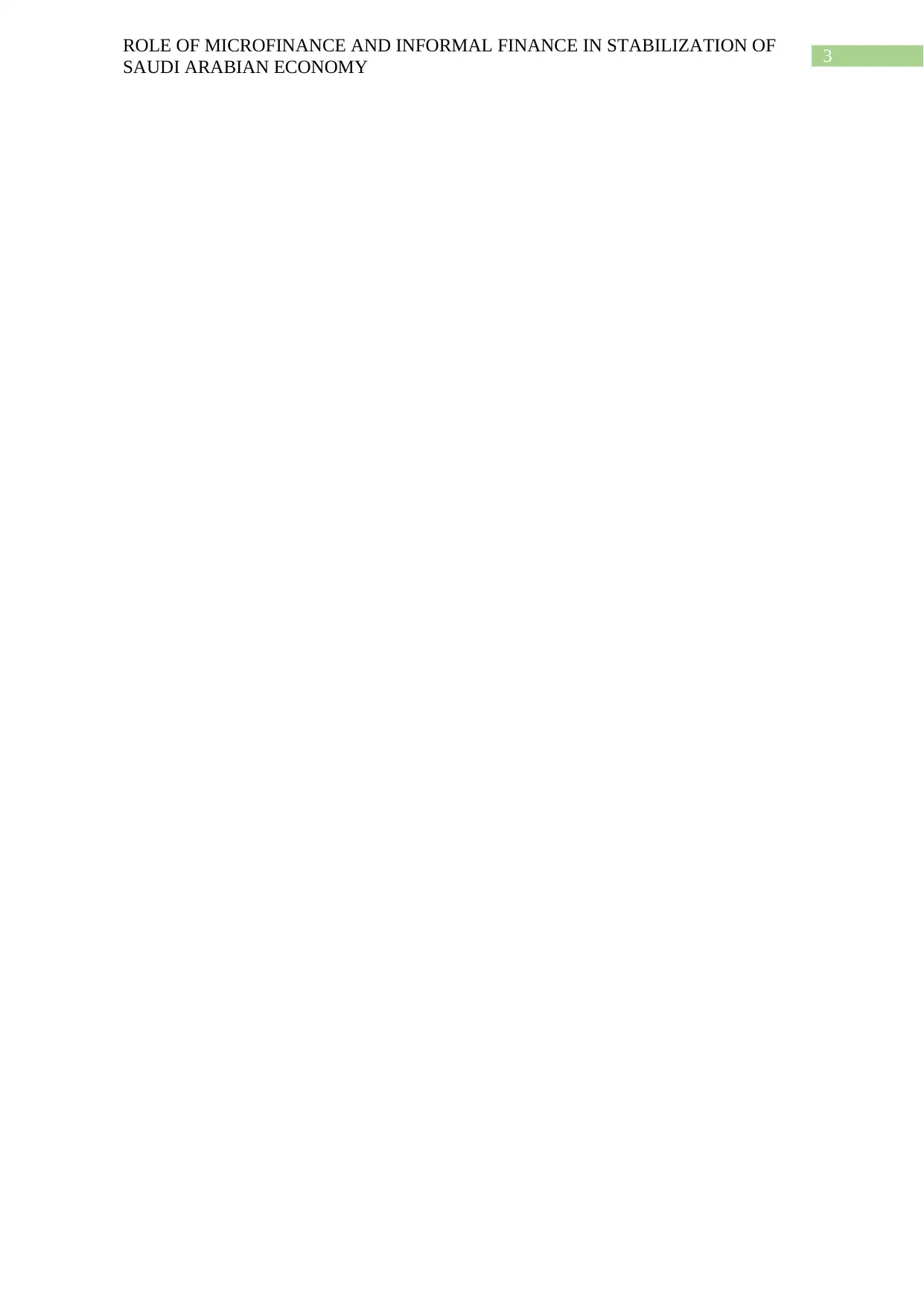
3
ROLE OF MICROFINANCE AND INFORMAL FINANCE IN STABILIZATION OF
SAUDI ARABIAN ECONOMY
ROLE OF MICROFINANCE AND INFORMAL FINANCE IN STABILIZATION OF
SAUDI ARABIAN ECONOMY
Paraphrase This Document
Need a fresh take? Get an instant paraphrase of this document with our AI Paraphraser

4
ROLE OF MICROFINANCE AND INFORMAL FINANCE IN STABILIZATION OF
SAUDI ARABIAN ECONOMY
Chapter 1: Introduction
Industries and businesses need investments to start operation and remain functional,
and these investments come from different modes of finance. Finance is thus one of the
primary necessity for a business that needs to be fulfilled. Recognizing the need for monetary
assistance banking and non-banking financial institutions emerged. However, the service of
the financial sector had been limited to big businesses. The micro, small and medium
enterprises are not always able to get finance from banks and other formal financial
institutions. It led to the emergence of the informal financial sector. Informal financial sector
contrarily charges a higher rate of interest that formal sector. In every developing or
emerging economies, both formal and informal financial sector exists. Microfinance policies
and informal sector, therefore, must have some impact on the financial sector as it caters to a
large sector of a developing economy.
1.1 Background of the study
Microfinance is related to the financial support to the poor people who are deprived of
financial services and supports from the mainstream financial institutions. Mainstream
financial institutions are mostly interested in lending to big business firms and try to lend all
their designated amount of money for a loan to them. Thus, in Saudi Arabia, the policy for
financing poor and micro, small and medium enterprises (MSME) have been implemented,
and this policy of finance is known as the microfinance. Previously, the poor had no options
other than taking a loan from informal, but with the introduction of microfinance, the
financial conditions of the poor and MSMEs have improved. However, there occurred a
change in the financial sector, with the introduction of microfinance in Saudi Arabia. The
impact of the microfinance and informal finance in the financial sector of Saudi Arabia needs
to be assessed.
ROLE OF MICROFINANCE AND INFORMAL FINANCE IN STABILIZATION OF
SAUDI ARABIAN ECONOMY
Chapter 1: Introduction
Industries and businesses need investments to start operation and remain functional,
and these investments come from different modes of finance. Finance is thus one of the
primary necessity for a business that needs to be fulfilled. Recognizing the need for monetary
assistance banking and non-banking financial institutions emerged. However, the service of
the financial sector had been limited to big businesses. The micro, small and medium
enterprises are not always able to get finance from banks and other formal financial
institutions. It led to the emergence of the informal financial sector. Informal financial sector
contrarily charges a higher rate of interest that formal sector. In every developing or
emerging economies, both formal and informal financial sector exists. Microfinance policies
and informal sector, therefore, must have some impact on the financial sector as it caters to a
large sector of a developing economy.
1.1 Background of the study
Microfinance is related to the financial support to the poor people who are deprived of
financial services and supports from the mainstream financial institutions. Mainstream
financial institutions are mostly interested in lending to big business firms and try to lend all
their designated amount of money for a loan to them. Thus, in Saudi Arabia, the policy for
financing poor and micro, small and medium enterprises (MSME) have been implemented,
and this policy of finance is known as the microfinance. Previously, the poor had no options
other than taking a loan from informal, but with the introduction of microfinance, the
financial conditions of the poor and MSMEs have improved. However, there occurred a
change in the financial sector, with the introduction of microfinance in Saudi Arabia. The
impact of the microfinance and informal finance in the financial sector of Saudi Arabia needs
to be assessed.
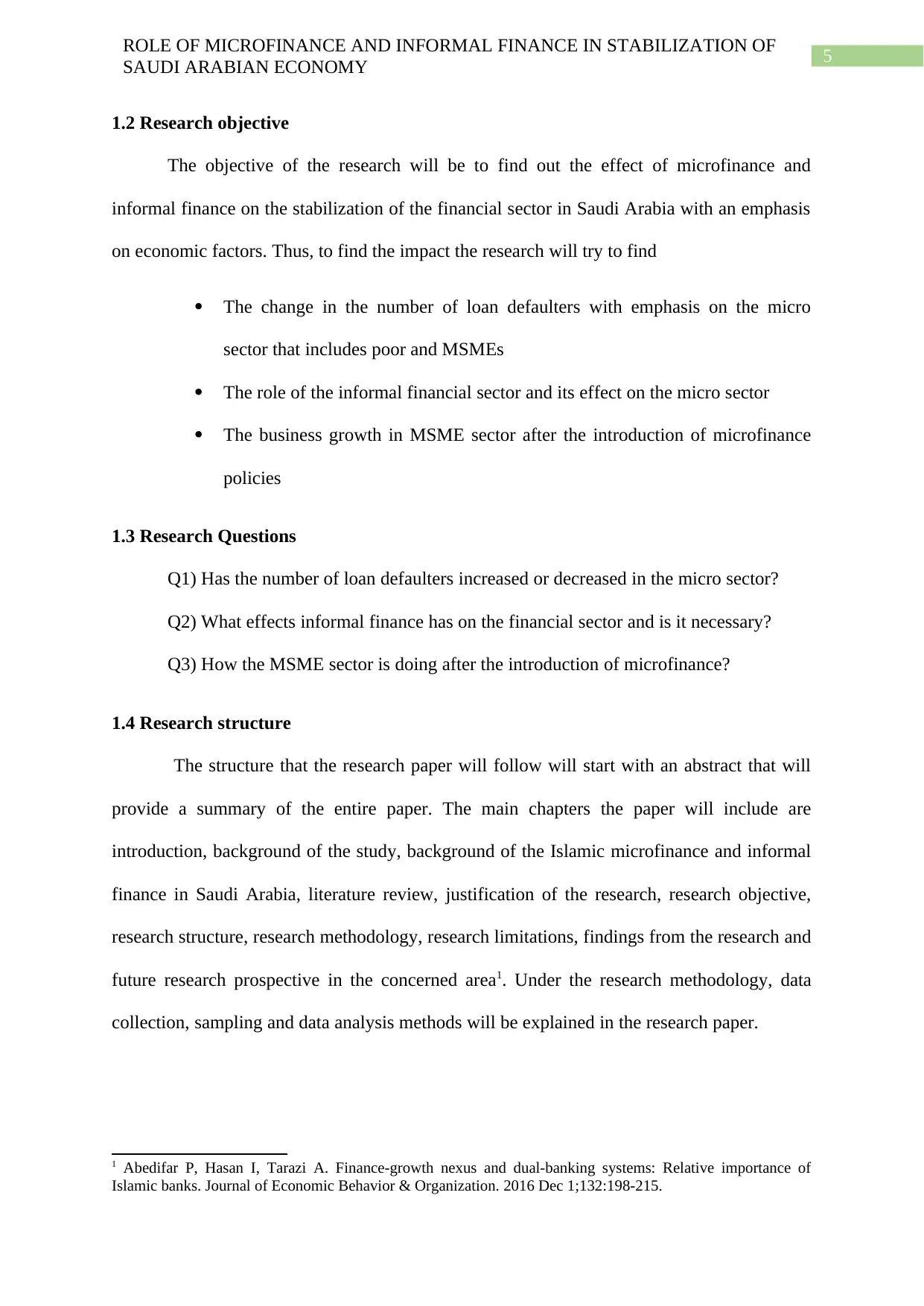
5
ROLE OF MICROFINANCE AND INFORMAL FINANCE IN STABILIZATION OF
SAUDI ARABIAN ECONOMY
1.2 Research objective
The objective of the research will be to find out the effect of microfinance and
informal finance on the stabilization of the financial sector in Saudi Arabia with an emphasis
on economic factors. Thus, to find the impact the research will try to find
The change in the number of loan defaulters with emphasis on the micro
sector that includes poor and MSMEs
The role of the informal financial sector and its effect on the micro sector
The business growth in MSME sector after the introduction of microfinance
policies
1.3 Research Questions
Q1) Has the number of loan defaulters increased or decreased in the micro sector?
Q2) What effects informal finance has on the financial sector and is it necessary?
Q3) How the MSME sector is doing after the introduction of microfinance?
1.4 Research structure
The structure that the research paper will follow will start with an abstract that will
provide a summary of the entire paper. The main chapters the paper will include are
introduction, background of the study, background of the Islamic microfinance and informal
finance in Saudi Arabia, literature review, justification of the research, research objective,
research structure, research methodology, research limitations, findings from the research and
future research prospective in the concerned area1. Under the research methodology, data
collection, sampling and data analysis methods will be explained in the research paper.
1 Abedifar P, Hasan I, Tarazi A. Finance-growth nexus and dual-banking systems: Relative importance of
Islamic banks. Journal of Economic Behavior & Organization. 2016 Dec 1;132:198-215.
ROLE OF MICROFINANCE AND INFORMAL FINANCE IN STABILIZATION OF
SAUDI ARABIAN ECONOMY
1.2 Research objective
The objective of the research will be to find out the effect of microfinance and
informal finance on the stabilization of the financial sector in Saudi Arabia with an emphasis
on economic factors. Thus, to find the impact the research will try to find
The change in the number of loan defaulters with emphasis on the micro
sector that includes poor and MSMEs
The role of the informal financial sector and its effect on the micro sector
The business growth in MSME sector after the introduction of microfinance
policies
1.3 Research Questions
Q1) Has the number of loan defaulters increased or decreased in the micro sector?
Q2) What effects informal finance has on the financial sector and is it necessary?
Q3) How the MSME sector is doing after the introduction of microfinance?
1.4 Research structure
The structure that the research paper will follow will start with an abstract that will
provide a summary of the entire paper. The main chapters the paper will include are
introduction, background of the study, background of the Islamic microfinance and informal
finance in Saudi Arabia, literature review, justification of the research, research objective,
research structure, research methodology, research limitations, findings from the research and
future research prospective in the concerned area1. Under the research methodology, data
collection, sampling and data analysis methods will be explained in the research paper.
1 Abedifar P, Hasan I, Tarazi A. Finance-growth nexus and dual-banking systems: Relative importance of
Islamic banks. Journal of Economic Behavior & Organization. 2016 Dec 1;132:198-215.
⊘ This is a preview!⊘
Do you want full access?
Subscribe today to unlock all pages.

Trusted by 1+ million students worldwide
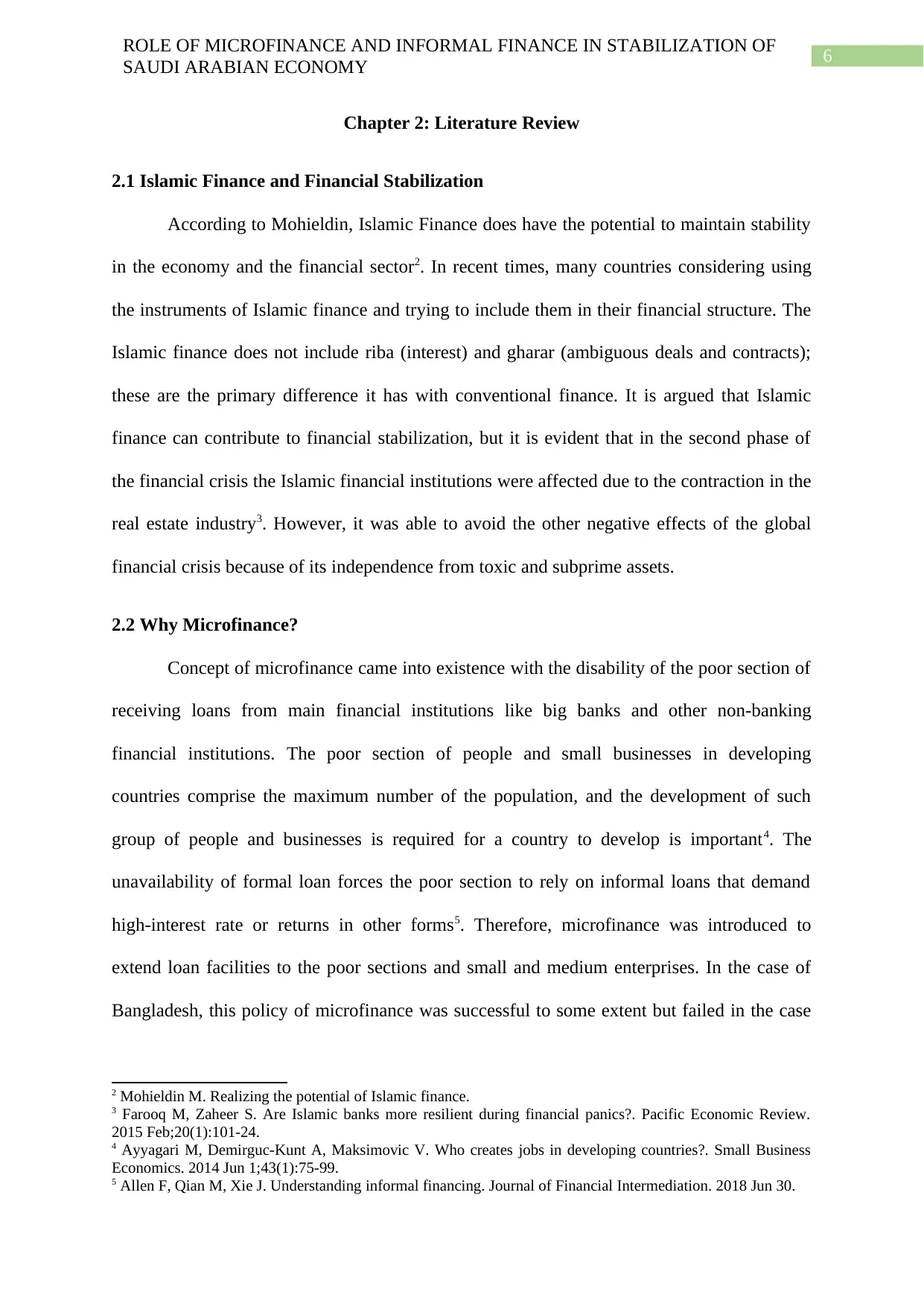
6
ROLE OF MICROFINANCE AND INFORMAL FINANCE IN STABILIZATION OF
SAUDI ARABIAN ECONOMY
Chapter 2: Literature Review
2.1 Islamic Finance and Financial Stabilization
According to Mohieldin, Islamic Finance does have the potential to maintain stability
in the economy and the financial sector2. In recent times, many countries considering using
the instruments of Islamic finance and trying to include them in their financial structure. The
Islamic finance does not include riba (interest) and gharar (ambiguous deals and contracts);
these are the primary difference it has with conventional finance. It is argued that Islamic
finance can contribute to financial stabilization, but it is evident that in the second phase of
the financial crisis the Islamic financial institutions were affected due to the contraction in the
real estate industry3. However, it was able to avoid the other negative effects of the global
financial crisis because of its independence from toxic and subprime assets.
2.2 Why Microfinance?
Concept of microfinance came into existence with the disability of the poor section of
receiving loans from main financial institutions like big banks and other non-banking
financial institutions. The poor section of people and small businesses in developing
countries comprise the maximum number of the population, and the development of such
group of people and businesses is required for a country to develop is important4. The
unavailability of formal loan forces the poor section to rely on informal loans that demand
high-interest rate or returns in other forms5. Therefore, microfinance was introduced to
extend loan facilities to the poor sections and small and medium enterprises. In the case of
Bangladesh, this policy of microfinance was successful to some extent but failed in the case
2 Mohieldin M. Realizing the potential of Islamic finance.
3 Farooq M, Zaheer S. Are Islamic banks more resilient during financial panics?. Pacific Economic Review.
2015 Feb;20(1):101-24.
4 Ayyagari M, Demirguc-Kunt A, Maksimovic V. Who creates jobs in developing countries?. Small Business
Economics. 2014 Jun 1;43(1):75-99.
5 Allen F, Qian M, Xie J. Understanding informal financing. Journal of Financial Intermediation. 2018 Jun 30.
ROLE OF MICROFINANCE AND INFORMAL FINANCE IN STABILIZATION OF
SAUDI ARABIAN ECONOMY
Chapter 2: Literature Review
2.1 Islamic Finance and Financial Stabilization
According to Mohieldin, Islamic Finance does have the potential to maintain stability
in the economy and the financial sector2. In recent times, many countries considering using
the instruments of Islamic finance and trying to include them in their financial structure. The
Islamic finance does not include riba (interest) and gharar (ambiguous deals and contracts);
these are the primary difference it has with conventional finance. It is argued that Islamic
finance can contribute to financial stabilization, but it is evident that in the second phase of
the financial crisis the Islamic financial institutions were affected due to the contraction in the
real estate industry3. However, it was able to avoid the other negative effects of the global
financial crisis because of its independence from toxic and subprime assets.
2.2 Why Microfinance?
Concept of microfinance came into existence with the disability of the poor section of
receiving loans from main financial institutions like big banks and other non-banking
financial institutions. The poor section of people and small businesses in developing
countries comprise the maximum number of the population, and the development of such
group of people and businesses is required for a country to develop is important4. The
unavailability of formal loan forces the poor section to rely on informal loans that demand
high-interest rate or returns in other forms5. Therefore, microfinance was introduced to
extend loan facilities to the poor sections and small and medium enterprises. In the case of
Bangladesh, this policy of microfinance was successful to some extent but failed in the case
2 Mohieldin M. Realizing the potential of Islamic finance.
3 Farooq M, Zaheer S. Are Islamic banks more resilient during financial panics?. Pacific Economic Review.
2015 Feb;20(1):101-24.
4 Ayyagari M, Demirguc-Kunt A, Maksimovic V. Who creates jobs in developing countries?. Small Business
Economics. 2014 Jun 1;43(1):75-99.
5 Allen F, Qian M, Xie J. Understanding informal financing. Journal of Financial Intermediation. 2018 Jun 30.
Paraphrase This Document
Need a fresh take? Get an instant paraphrase of this document with our AI Paraphraser
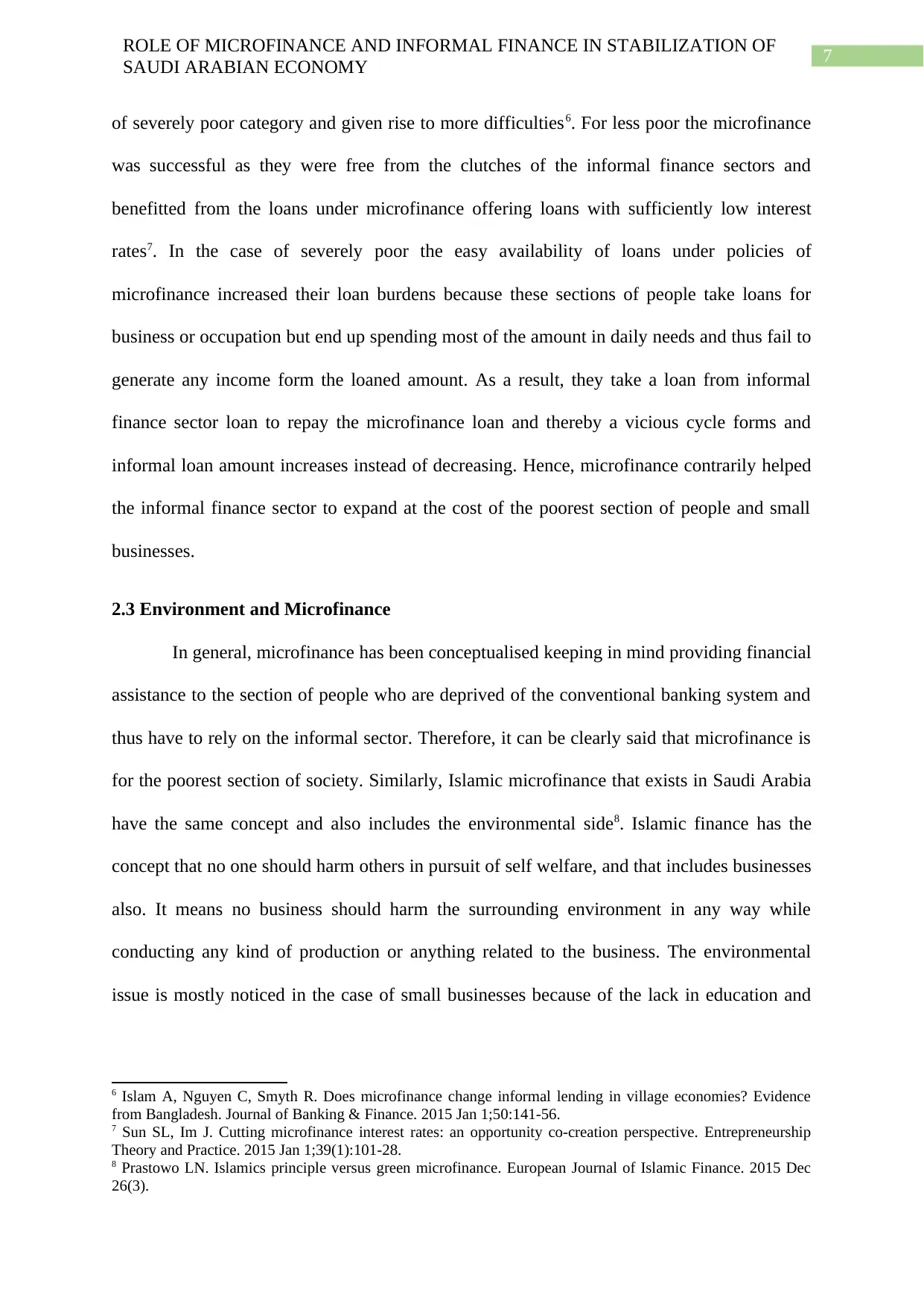
7
ROLE OF MICROFINANCE AND INFORMAL FINANCE IN STABILIZATION OF
SAUDI ARABIAN ECONOMY
of severely poor category and given rise to more difficulties6. For less poor the microfinance
was successful as they were free from the clutches of the informal finance sectors and
benefitted from the loans under microfinance offering loans with sufficiently low interest
rates7. In the case of severely poor the easy availability of loans under policies of
microfinance increased their loan burdens because these sections of people take loans for
business or occupation but end up spending most of the amount in daily needs and thus fail to
generate any income form the loaned amount. As a result, they take a loan from informal
finance sector loan to repay the microfinance loan and thereby a vicious cycle forms and
informal loan amount increases instead of decreasing. Hence, microfinance contrarily helped
the informal finance sector to expand at the cost of the poorest section of people and small
businesses.
2.3 Environment and Microfinance
In general, microfinance has been conceptualised keeping in mind providing financial
assistance to the section of people who are deprived of the conventional banking system and
thus have to rely on the informal sector. Therefore, it can be clearly said that microfinance is
for the poorest section of society. Similarly, Islamic microfinance that exists in Saudi Arabia
have the same concept and also includes the environmental side8. Islamic finance has the
concept that no one should harm others in pursuit of self welfare, and that includes businesses
also. It means no business should harm the surrounding environment in any way while
conducting any kind of production or anything related to the business. The environmental
issue is mostly noticed in the case of small businesses because of the lack in education and
6 Islam A, Nguyen C, Smyth R. Does microfinance change informal lending in village economies? Evidence
from Bangladesh. Journal of Banking & Finance. 2015 Jan 1;50:141-56.
7 Sun SL, Im J. Cutting microfinance interest rates: an opportunity co‐creation perspective. Entrepreneurship
Theory and Practice. 2015 Jan 1;39(1):101-28.
8 Prastowo LN. Islamics principle versus green microfinance. European Journal of Islamic Finance. 2015 Dec
26(3).
ROLE OF MICROFINANCE AND INFORMAL FINANCE IN STABILIZATION OF
SAUDI ARABIAN ECONOMY
of severely poor category and given rise to more difficulties6. For less poor the microfinance
was successful as they were free from the clutches of the informal finance sectors and
benefitted from the loans under microfinance offering loans with sufficiently low interest
rates7. In the case of severely poor the easy availability of loans under policies of
microfinance increased their loan burdens because these sections of people take loans for
business or occupation but end up spending most of the amount in daily needs and thus fail to
generate any income form the loaned amount. As a result, they take a loan from informal
finance sector loan to repay the microfinance loan and thereby a vicious cycle forms and
informal loan amount increases instead of decreasing. Hence, microfinance contrarily helped
the informal finance sector to expand at the cost of the poorest section of people and small
businesses.
2.3 Environment and Microfinance
In general, microfinance has been conceptualised keeping in mind providing financial
assistance to the section of people who are deprived of the conventional banking system and
thus have to rely on the informal sector. Therefore, it can be clearly said that microfinance is
for the poorest section of society. Similarly, Islamic microfinance that exists in Saudi Arabia
have the same concept and also includes the environmental side8. Islamic finance has the
concept that no one should harm others in pursuit of self welfare, and that includes businesses
also. It means no business should harm the surrounding environment in any way while
conducting any kind of production or anything related to the business. The environmental
issue is mostly noticed in the case of small businesses because of the lack in education and
6 Islam A, Nguyen C, Smyth R. Does microfinance change informal lending in village economies? Evidence
from Bangladesh. Journal of Banking & Finance. 2015 Jan 1;50:141-56.
7 Sun SL, Im J. Cutting microfinance interest rates: an opportunity co‐creation perspective. Entrepreneurship
Theory and Practice. 2015 Jan 1;39(1):101-28.
8 Prastowo LN. Islamics principle versus green microfinance. European Journal of Islamic Finance. 2015 Dec
26(3).
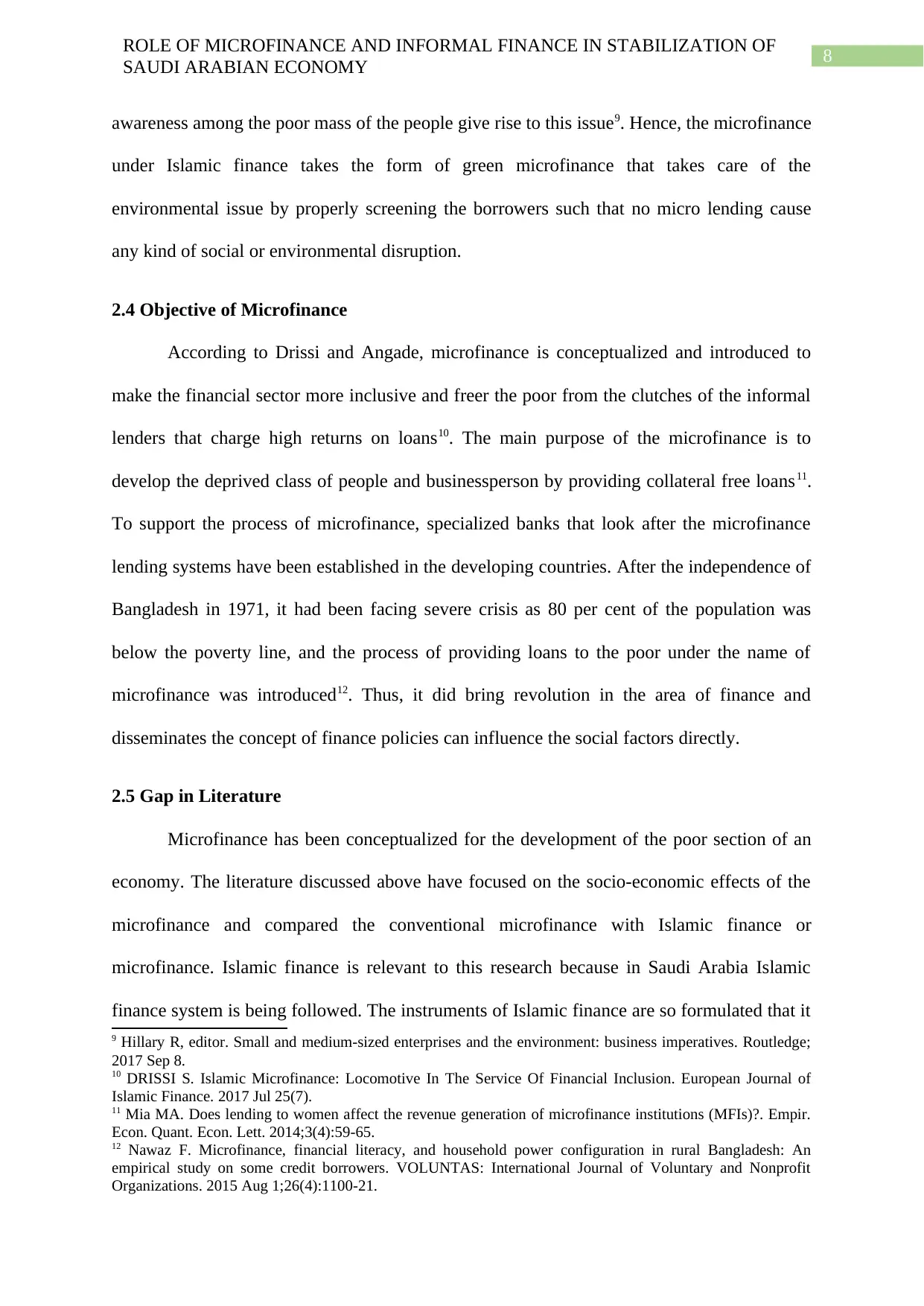
8
ROLE OF MICROFINANCE AND INFORMAL FINANCE IN STABILIZATION OF
SAUDI ARABIAN ECONOMY
awareness among the poor mass of the people give rise to this issue9. Hence, the microfinance
under Islamic finance takes the form of green microfinance that takes care of the
environmental issue by properly screening the borrowers such that no micro lending cause
any kind of social or environmental disruption.
2.4 Objective of Microfinance
According to Drissi and Angade, microfinance is conceptualized and introduced to
make the financial sector more inclusive and freer the poor from the clutches of the informal
lenders that charge high returns on loans10. The main purpose of the microfinance is to
develop the deprived class of people and businessperson by providing collateral free loans11.
To support the process of microfinance, specialized banks that look after the microfinance
lending systems have been established in the developing countries. After the independence of
Bangladesh in 1971, it had been facing severe crisis as 80 per cent of the population was
below the poverty line, and the process of providing loans to the poor under the name of
microfinance was introduced12. Thus, it did bring revolution in the area of finance and
disseminates the concept of finance policies can influence the social factors directly.
2.5 Gap in Literature
Microfinance has been conceptualized for the development of the poor section of an
economy. The literature discussed above have focused on the socio-economic effects of the
microfinance and compared the conventional microfinance with Islamic finance or
microfinance. Islamic finance is relevant to this research because in Saudi Arabia Islamic
finance system is being followed. The instruments of Islamic finance are so formulated that it
9 Hillary R, editor. Small and medium-sized enterprises and the environment: business imperatives. Routledge;
2017 Sep 8.
10 DRISSI S. Islamic Microfinance: Locomotive In The Service Of Financial Inclusion. European Journal of
Islamic Finance. 2017 Jul 25(7).
11 Mia MA. Does lending to women affect the revenue generation of microfinance institutions (MFIs)?. Empir.
Econ. Quant. Econ. Lett. 2014;3(4):59-65.
12 Nawaz F. Microfinance, financial literacy, and household power configuration in rural Bangladesh: An
empirical study on some credit borrowers. VOLUNTAS: International Journal of Voluntary and Nonprofit
Organizations. 2015 Aug 1;26(4):1100-21.
ROLE OF MICROFINANCE AND INFORMAL FINANCE IN STABILIZATION OF
SAUDI ARABIAN ECONOMY
awareness among the poor mass of the people give rise to this issue9. Hence, the microfinance
under Islamic finance takes the form of green microfinance that takes care of the
environmental issue by properly screening the borrowers such that no micro lending cause
any kind of social or environmental disruption.
2.4 Objective of Microfinance
According to Drissi and Angade, microfinance is conceptualized and introduced to
make the financial sector more inclusive and freer the poor from the clutches of the informal
lenders that charge high returns on loans10. The main purpose of the microfinance is to
develop the deprived class of people and businessperson by providing collateral free loans11.
To support the process of microfinance, specialized banks that look after the microfinance
lending systems have been established in the developing countries. After the independence of
Bangladesh in 1971, it had been facing severe crisis as 80 per cent of the population was
below the poverty line, and the process of providing loans to the poor under the name of
microfinance was introduced12. Thus, it did bring revolution in the area of finance and
disseminates the concept of finance policies can influence the social factors directly.
2.5 Gap in Literature
Microfinance has been conceptualized for the development of the poor section of an
economy. The literature discussed above have focused on the socio-economic effects of the
microfinance and compared the conventional microfinance with Islamic finance or
microfinance. Islamic finance is relevant to this research because in Saudi Arabia Islamic
finance system is being followed. The instruments of Islamic finance are so formulated that it
9 Hillary R, editor. Small and medium-sized enterprises and the environment: business imperatives. Routledge;
2017 Sep 8.
10 DRISSI S. Islamic Microfinance: Locomotive In The Service Of Financial Inclusion. European Journal of
Islamic Finance. 2017 Jul 25(7).
11 Mia MA. Does lending to women affect the revenue generation of microfinance institutions (MFIs)?. Empir.
Econ. Quant. Econ. Lett. 2014;3(4):59-65.
12 Nawaz F. Microfinance, financial literacy, and household power configuration in rural Bangladesh: An
empirical study on some credit borrowers. VOLUNTAS: International Journal of Voluntary and Nonprofit
Organizations. 2015 Aug 1;26(4):1100-21.
⊘ This is a preview!⊘
Do you want full access?
Subscribe today to unlock all pages.

Trusted by 1+ million students worldwide
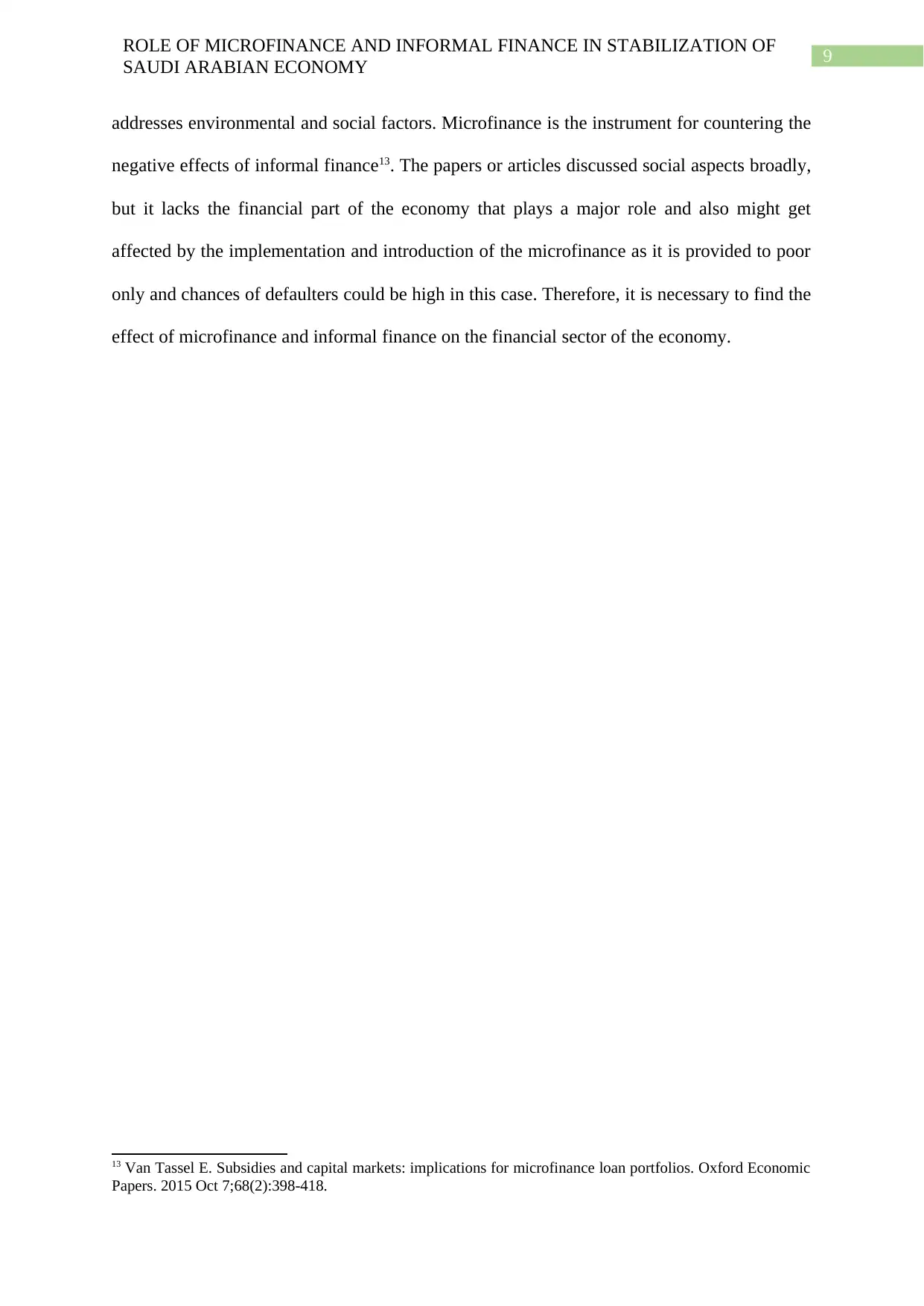
9
ROLE OF MICROFINANCE AND INFORMAL FINANCE IN STABILIZATION OF
SAUDI ARABIAN ECONOMY
addresses environmental and social factors. Microfinance is the instrument for countering the
negative effects of informal finance13. The papers or articles discussed social aspects broadly,
but it lacks the financial part of the economy that plays a major role and also might get
affected by the implementation and introduction of the microfinance as it is provided to poor
only and chances of defaulters could be high in this case. Therefore, it is necessary to find the
effect of microfinance and informal finance on the financial sector of the economy.
13 Van Tassel E. Subsidies and capital markets: implications for microfinance loan portfolios. Oxford Economic
Papers. 2015 Oct 7;68(2):398-418.
ROLE OF MICROFINANCE AND INFORMAL FINANCE IN STABILIZATION OF
SAUDI ARABIAN ECONOMY
addresses environmental and social factors. Microfinance is the instrument for countering the
negative effects of informal finance13. The papers or articles discussed social aspects broadly,
but it lacks the financial part of the economy that plays a major role and also might get
affected by the implementation and introduction of the microfinance as it is provided to poor
only and chances of defaulters could be high in this case. Therefore, it is necessary to find the
effect of microfinance and informal finance on the financial sector of the economy.
13 Van Tassel E. Subsidies and capital markets: implications for microfinance loan portfolios. Oxford Economic
Papers. 2015 Oct 7;68(2):398-418.
Paraphrase This Document
Need a fresh take? Get an instant paraphrase of this document with our AI Paraphraser

10
ROLE OF MICROFINANCE AND INFORMAL FINANCE IN STABILIZATION OF
SAUDI ARABIAN ECONOMY
Chapter 3: Research Methodology
The research will be done by using both secondary research and primary research.
Under secondary research, the articles related to the concerned topic will be examined14. The
findings of different studies will be compiled and compared. Data on microfinance and
informal finance will be collected from the authentic sources mainly from government and
reliable company and banks sites that provide microfinance loans. On the other hand, primary
research will be based on the primary data collected from the different sources directly by
interviewing.
3.1 Research Approach
The design of the research methodology that will be used in the concerned research
paper includes survey, interviews, and internet-based researches. All the methods are popular
in the field of research and are well recognized. No new methods of research will be used in
the research, and thus, the research approach is a deductive one.
3.2 Data Collection
The primary research will be sub-divided into two forms, namely qualitative and
quantitative. Under primary qualitative research, formal interviews of the official of the
financial institutions like banks, and non-banking financial corporations will be done15. The
banks will include both the microfinance banks and big commercial banks. Other than
financial institutions, the borrowers of the loans will also be interviewed, and it will include
big companies. In these cases, there will be no structured questionnaire. The structured
questionnaire will be developed for borrowers of the microfinance loans, informal loans and
the lenders of the informal finance providers. The qualitative data will be collected by
interviewing the officials and it will focus on the structure of the microfinance loans, its key
14 Kumar R. Research methodology: A step-by-step guide for beginners. Sage Publications Limited; 2019 Jan 2.
15 Gentles SJ, Charles C, Ploeg J, McKibbon K. Sampling in qualitative research: Insights from an overview of
the methods literature. The Qualitative Report. 2015;20(11):1772-89.
ROLE OF MICROFINANCE AND INFORMAL FINANCE IN STABILIZATION OF
SAUDI ARABIAN ECONOMY
Chapter 3: Research Methodology
The research will be done by using both secondary research and primary research.
Under secondary research, the articles related to the concerned topic will be examined14. The
findings of different studies will be compiled and compared. Data on microfinance and
informal finance will be collected from the authentic sources mainly from government and
reliable company and banks sites that provide microfinance loans. On the other hand, primary
research will be based on the primary data collected from the different sources directly by
interviewing.
3.1 Research Approach
The design of the research methodology that will be used in the concerned research
paper includes survey, interviews, and internet-based researches. All the methods are popular
in the field of research and are well recognized. No new methods of research will be used in
the research, and thus, the research approach is a deductive one.
3.2 Data Collection
The primary research will be sub-divided into two forms, namely qualitative and
quantitative. Under primary qualitative research, formal interviews of the official of the
financial institutions like banks, and non-banking financial corporations will be done15. The
banks will include both the microfinance banks and big commercial banks. Other than
financial institutions, the borrowers of the loans will also be interviewed, and it will include
big companies. In these cases, there will be no structured questionnaire. The structured
questionnaire will be developed for borrowers of the microfinance loans, informal loans and
the lenders of the informal finance providers. The qualitative data will be collected by
interviewing the officials and it will focus on the structure of the microfinance loans, its key
14 Kumar R. Research methodology: A step-by-step guide for beginners. Sage Publications Limited; 2019 Jan 2.
15 Gentles SJ, Charles C, Ploeg J, McKibbon K. Sampling in qualitative research: Insights from an overview of
the methods literature. The Qualitative Report. 2015;20(11):1772-89.
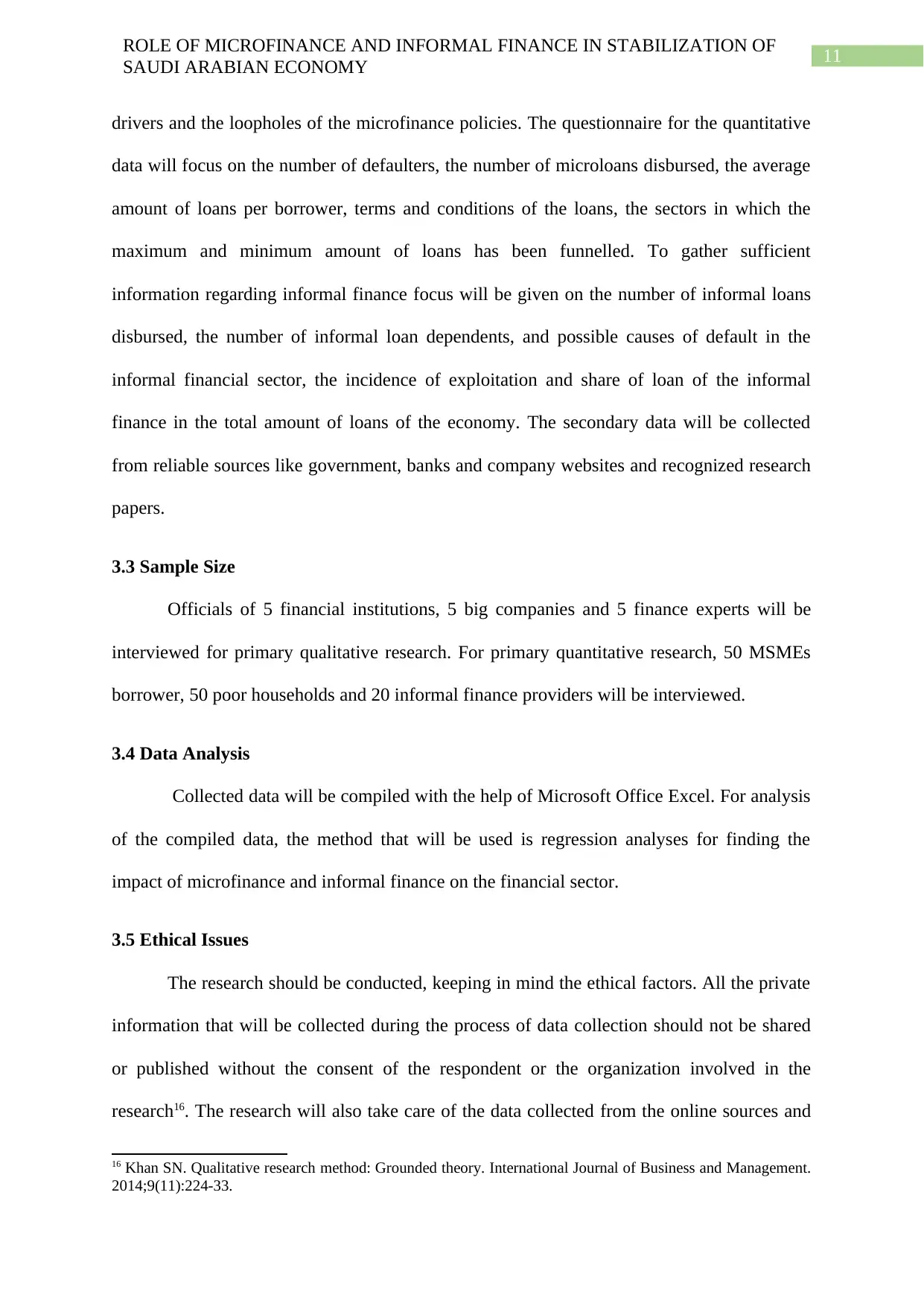
11
ROLE OF MICROFINANCE AND INFORMAL FINANCE IN STABILIZATION OF
SAUDI ARABIAN ECONOMY
drivers and the loopholes of the microfinance policies. The questionnaire for the quantitative
data will focus on the number of defaulters, the number of microloans disbursed, the average
amount of loans per borrower, terms and conditions of the loans, the sectors in which the
maximum and minimum amount of loans has been funnelled. To gather sufficient
information regarding informal finance focus will be given on the number of informal loans
disbursed, the number of informal loan dependents, and possible causes of default in the
informal financial sector, the incidence of exploitation and share of loan of the informal
finance in the total amount of loans of the economy. The secondary data will be collected
from reliable sources like government, banks and company websites and recognized research
papers.
3.3 Sample Size
Officials of 5 financial institutions, 5 big companies and 5 finance experts will be
interviewed for primary qualitative research. For primary quantitative research, 50 MSMEs
borrower, 50 poor households and 20 informal finance providers will be interviewed.
3.4 Data Analysis
Collected data will be compiled with the help of Microsoft Office Excel. For analysis
of the compiled data, the method that will be used is regression analyses for finding the
impact of microfinance and informal finance on the financial sector.
3.5 Ethical Issues
The research should be conducted, keeping in mind the ethical factors. All the private
information that will be collected during the process of data collection should not be shared
or published without the consent of the respondent or the organization involved in the
research16. The research will also take care of the data collected from the online sources and
16 Khan SN. Qualitative research method: Grounded theory. International Journal of Business and Management.
2014;9(11):224-33.
ROLE OF MICROFINANCE AND INFORMAL FINANCE IN STABILIZATION OF
SAUDI ARABIAN ECONOMY
drivers and the loopholes of the microfinance policies. The questionnaire for the quantitative
data will focus on the number of defaulters, the number of microloans disbursed, the average
amount of loans per borrower, terms and conditions of the loans, the sectors in which the
maximum and minimum amount of loans has been funnelled. To gather sufficient
information regarding informal finance focus will be given on the number of informal loans
disbursed, the number of informal loan dependents, and possible causes of default in the
informal financial sector, the incidence of exploitation and share of loan of the informal
finance in the total amount of loans of the economy. The secondary data will be collected
from reliable sources like government, banks and company websites and recognized research
papers.
3.3 Sample Size
Officials of 5 financial institutions, 5 big companies and 5 finance experts will be
interviewed for primary qualitative research. For primary quantitative research, 50 MSMEs
borrower, 50 poor households and 20 informal finance providers will be interviewed.
3.4 Data Analysis
Collected data will be compiled with the help of Microsoft Office Excel. For analysis
of the compiled data, the method that will be used is regression analyses for finding the
impact of microfinance and informal finance on the financial sector.
3.5 Ethical Issues
The research should be conducted, keeping in mind the ethical factors. All the private
information that will be collected during the process of data collection should not be shared
or published without the consent of the respondent or the organization involved in the
research16. The research will also take care of the data collected from the online sources and
16 Khan SN. Qualitative research method: Grounded theory. International Journal of Business and Management.
2014;9(11):224-33.
⊘ This is a preview!⊘
Do you want full access?
Subscribe today to unlock all pages.

Trusted by 1+ million students worldwide
1 out of 16
Related Documents
Your All-in-One AI-Powered Toolkit for Academic Success.
+13062052269
info@desklib.com
Available 24*7 on WhatsApp / Email
![[object Object]](/_next/static/media/star-bottom.7253800d.svg)
Unlock your academic potential
Copyright © 2020–2025 A2Z Services. All Rights Reserved. Developed and managed by ZUCOL.




